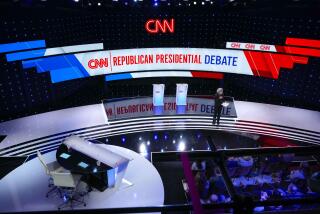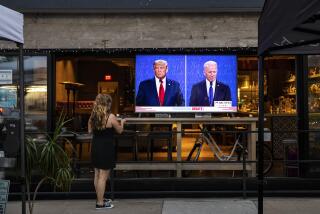McManus: Attack ad politics
In this pivotal election year, fellow citizens, I give you a chilling vision of two Americas.
One America is the swing states, the dozen or so states that don’t fall into the Democratic or Republican camps and will ultimately decide the presidential election. Those unhappy states — they know who they are — are already being flooded with noisy political advertising, day and night.
The other America, the happier America, is what political strategists call “safe states.” In these lucky places, television viewers are mostly safe from being inundated with presidential political harangues.
COMMENTARY AND ANALYSIS: Presidential Election 2012
Election day is almost four months away, but the bombardment has begun in key swing cities such as Columbus, Ohio, and Orlando, Fla., where television stations are already running short of advertising time to sell. One media consulting firm, Borrell Associates, forecasts that political advertising this year will approach $10 billion nationwide, a huge increase from the roughly $7 billion spent in 2008.
If those numbers look suspiciously round, it’s because they’re just guesses. Nobody knows how much money will be spent because so much of the spending is coming from a new source, the “independent committees” that can raise money in unlimited amounts — and, in many cases, can keep their donors anonymous.
Political advertising, and spending on political advertising, isn’t inherently bad. Just ask the owners of those television stations, who have seen their businesses get a nice shot in the arm.
And even negative political ads — the ones with ominous music, accusing candidates of mismanaging the economy or flip-flopping or being unprepared to handle a crisis — aren’t inherently bad.
Scholars who study these things say that negative ads are often more informative — and even more accurate — than positive ads, in part because they get more scrutiny. When a candidate tells you he’s fighting for America’s families or working for better schools, who can prove him wrong? But if he calls his opponent a felon or — worse — a job outsourcer, he knows he’d better provide some evidence.
“Negative ads can be good because they generate a conversation,” argues John G. Geer, a political science professor at Vanderbilt University who watches ads so you don’t have to. “It’s a struggle between competing messages, and voters have to adjudicate their accuracy. But that’s what campaigns are about.”
This year, though, voters in the swing states are likely to have a harder time adjudicating the accuracy of the advertising they see. First, because there’s going to be so much of it. And second, because so much of it will come from those anonymous independent committees — and their commercials tend to be less scrupulous about the facts.
“Third-party ads are more deceptive because they’re less accountable; you can’t tie the candidate to them,” noted Kathleen Hall Jamieson of the Annenberg Public Policy Center, which runs a monitoring project called FactCheck.org. “And when they’re anonymous as well, we’ve already seen this year that those ads have a higher level of deception.”
So far, the new groups with anonymous donors are overwhelmingly Republican, and they have big plans. The Crossroads organization founded by former George W. Bushaide Karl Rove says it expects to raise $300 million; another, funded partly by the conservative Koch brothers, promises $400 million.
But that doesn’t mean Democrats have unilaterally disarmed: The “super PAC” supporting President Obama says it hopes to raise $100 million.
It also doesn’t mean that the GOP will have a monopoly on deceptive advertising.
FactCheck.org has identified problems with ads supporting each of the candidates. About an Obama ad that took aim at Bain Capital, the investment firm Romney once ran, the website concluded: “Some of the claims in the ads are untrue, and others are thinly supported.” A Romney ad questioning Obama’s loans and grants to the solar industry, including companies run by Democratic donors, “strains facts to make its point” and “twisted” the words of the Energy Department’s inspector general, the group found.
What can voters do about these ads? The first step is to watch them, whether you’re in a swing state or not. Many are available on YouTube or on the sites of watchdog groups.
The second step is to check their accuracy, by going to FactCheck.org or one of the other organizations that do the work of evaluating political advertising claims.
The third step, Jamieson says, is that if you think a commercial is deceptive, you can ask a television station manager to take it off the air until it’s been fixed. Stations are required to run commercials from candidates as is, but not commercials from independent groups.
The problem is that television stations like the millions of dollars in revenue they’re collecting for these ads, and they can charge a higher fee to independent committees than to candidates, who get a break on advertising rates.
“The stations don’t make money on the candidates,” Jamieson noted. “They make it from third-party groups.”
I don’t know how you’re spending your weekend, but I’m devoting mine to watching a bunch of these commercials. Next week, to celebrate my column’s move from Thursday to Wednesday, I’ll unveil my picks of the season’s best and worst ads so far.
More to Read
A cure for the common opinion
Get thought-provoking perspectives with our weekly newsletter.
You may occasionally receive promotional content from the Los Angeles Times.







